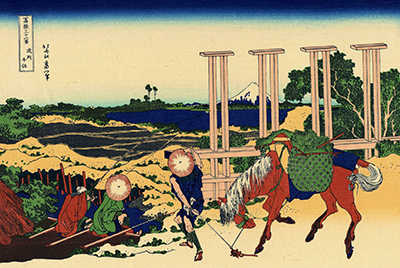Hokusai
Senju Musashi Province by Hokusai
Senju in Musashi Province or Bushū Senju, is one Katsushika Hokusai’s prints from the famous series The Thirty-six Views of Mount Fuji also called Fugaku sanjūrokkei. Katsushika Hokusai was born on 31st of October, 1760 in the Japan Edo District and died on the 10th of May 1849.
The print Senju Musashi Province was produced between 1830 and 1832 during the Edo period (1615-1868) in Japan. It was printed on a woodblock print; ink and colour on paper with dimensions of 9 5/8 x 15 in. (24.4 x 38.1 cm) and classified as a print using the Ukiyo-e style. Senju was a post town that is believed to be the first one on the highways of Nikko-dochu and Oshu-dochu. The town prospered as one of the major postal station in Edo Distirict.
Hokusai portrays a farmer with a horse and the angler hand seemingly over the shade looking up to The Mount Fuji. They may be talking about the panoramic view of the mountain as the horse walks leisurely. The geometrical sluice gate is drawn in front to highlight the beauty of the mountain. The Japanese practice have an extreme frequency that allowed Katsushika Hokusai to transition up to thirty pseudonyms throughout his career.
Interestingly, each of the names correlated to a different period or style of his artwork. His surname Hokusai prevailed and united all the other surplus monikers into a legacy of a legendary artist, printmaker, and a painter who used an Ukiyo-e style. He had depicted an Ukiyo-e style wood block prints before he revolutionized into a medium of landscapes that has images which define the daily life of the Japanese culture.
The 1831 series Thirty-six Views of Mount Fuji wood block series has the most popular all his works. Through the series, he mastered the unique relationship that exists between man and the environment. Furthermore, he was so passionate about the fascinating Mount Fuji that he was inspired to come up with various prints that portrayed The Mount Fuji from various locations, weathers, conditions and seasons. Although he wasn’t fully inspired by his father Nakajima Ise who was a mirror maker to start painting, he further honed his skills and art by joining the Tawaraya School where he adopted the name the Tawaraya son.
